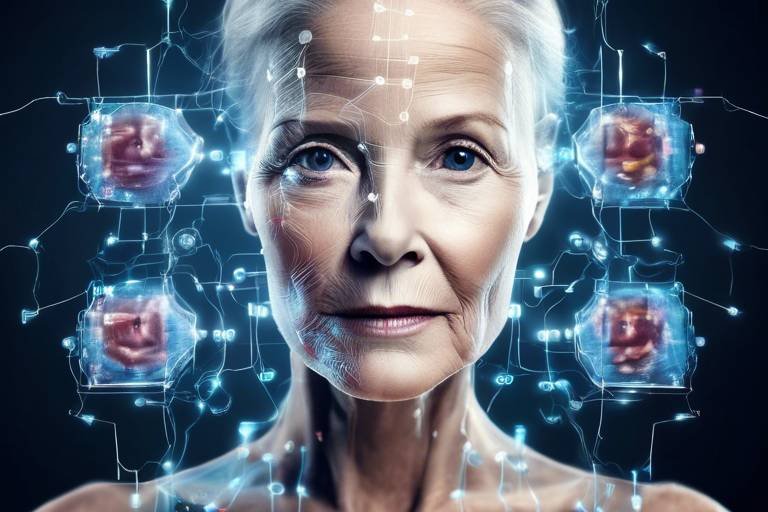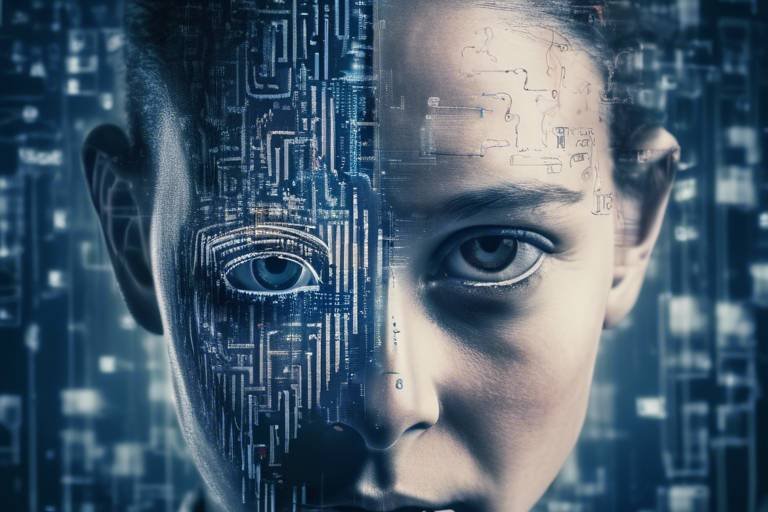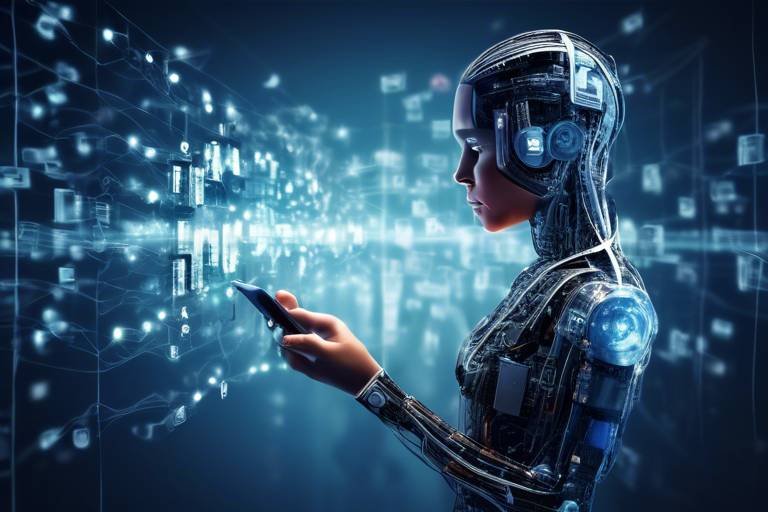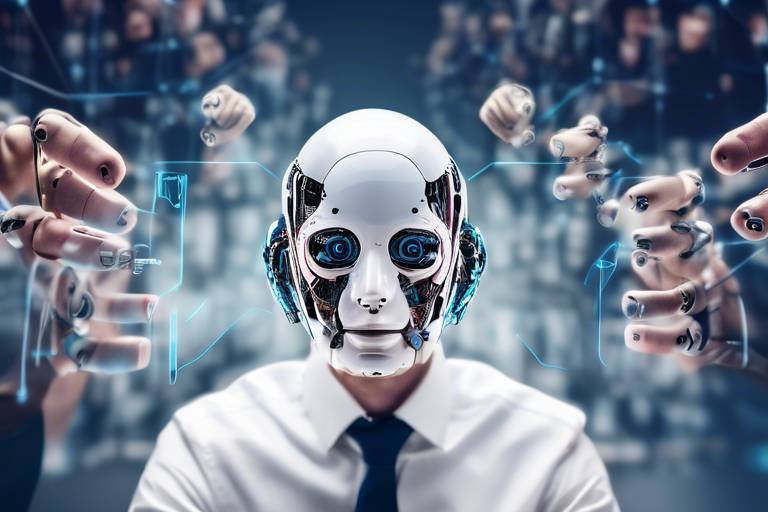The Potential of AI in Anti-Aging Research
The world of anti-aging research is undergoing a seismic shift, and at the forefront of this revolution is artificial intelligence (AI). Imagine a future where we can not only extend our lifespan but also enhance our health span—the period of life spent in good health. Sounds like science fiction, right? Well, thanks to AI, this dream is inching closer to reality. By harnessing the power of advanced algorithms and vast datasets, researchers are uncovering the secrets of aging like never before. This article delves into how AI is reshaping our understanding of aging, from drug discovery to personalized medicine, and the profound implications it holds for longevity.
Understanding the biological mechanisms of aging is crucial for developing effective therapies. Aging is not just a simple process; it’s a complex interplay of genetic, environmental, and lifestyle factors. AI can analyze extensive datasets to uncover insights into cellular processes and aging pathways, making it a valuable tool for researchers. For instance, AI can identify patterns in how cells age, leading to breakthroughs in interventions that could slow down or even reverse certain aspects of aging.
One of the most exciting areas where AI is making waves is in drug discovery. Traditional methods of discovering new drugs can be time-consuming and expensive, often taking years before a viable treatment is found. Enter AI, which significantly accelerates this process. By predicting molecular interactions and optimizing compounds, AI is paving the way for innovative anti-aging treatments and therapies. Imagine having a virtual lab where AI quickly tests thousands of compounds, identifying the most promising candidates in a fraction of the time it would take human researchers.
Machine learning algorithms play a pivotal role in this process. They can sift through existing research data to identify potential drug candidates and predict their effectiveness against age-related diseases. This not only enhances the efficiency of the discovery process but also opens doors to treatments that were previously thought to be unattainable. Furthermore, AI techniques can mine large datasets to identify biomarkers associated with aging. These biomarkers are like breadcrumbs, leading researchers to specific pathways for intervention and treatment development.
Another fascinating aspect of AI in drug development is predictive modeling. By simulating how drugs behave in the body, AI can provide insights that reduce the time and cost involved in bringing new anti-aging therapies to market. This means that not only could we see more treatments available sooner, but they could also be more effective, tailored to the unique biological makeup of individuals.
Speaking of tailoring treatments, AI is revolutionizing the field of personalized medicine. By analyzing individual genetic and health data, AI allows for the development of treatments that cater to unique patient profiles. This means that instead of a one-size-fits-all approach, we could have therapies specifically designed for you, based on your genetic makeup and health history. It’s like having a custom-made suit—perfectly fitted to your unique dimensions!
As we explore the potential of AI in anti-aging research, it’s essential to also consider the ethical implications of these advancements. The integration of AI raises important questions about equity in access to treatments and the long-term societal impacts of extending human life. As exciting as these developments are, we must ensure that all populations have access to these advancements. This is critical for ethical considerations in anti-aging research and healthcare.
Moreover, we need to examine the potential societal impacts of extending lifespan through AI-driven anti-aging research. This includes implications for healthcare systems, social structures, and overall quality of life. Will our healthcare systems be able to support an aging population living longer, healthier lives? Will the social dynamics shift as we redefine what it means to age? These are questions that require careful consideration as we move forward.
- How is AI being used in anti-aging research? AI is used to analyze large datasets, predict drug interactions, identify biomarkers, and develop personalized medicine approaches.
- What are the ethical concerns surrounding AI in anti-aging? Key concerns include equitable access to treatments and the societal impacts of extending human lifespan.
- Can AI help in discovering new anti-aging drugs? Yes, AI significantly accelerates the drug discovery process by predicting molecular interactions and optimizing compounds.
- What is personalized medicine? Personalized medicine tailors treatments to individual genetic and health profiles, enhancing effectiveness and reducing side effects.

Understanding Aging at the Molecular Level
Aging is often viewed as an inevitable part of life, but what if we could peel back the layers and understand the complex biological mechanisms that drive this process? By delving into the molecular level, we can uncover the secrets of aging and potentially unlock the key to extending our health span. Artificial Intelligence (AI) plays a pivotal role in this exploration, as it can analyze vast datasets and reveal insights into cellular processes and aging pathways that were previously beyond our reach.
At the core of aging lies a myriad of biological processes, including telomere shortening, oxidative stress, and the accumulation of senescent cells. Telomeres, the protective caps at the ends of our chromosomes, gradually shorten with each cell division, leading to cellular aging and dysfunction. This is akin to the fraying ends of shoelaces; eventually, they become too worn to hold everything together. AI can help us understand how to maintain telomere length or even rejuvenate these critical structures.
Additionally, oxidative stress plays a significant role in aging. As our cells metabolize energy, they produce reactive oxygen species (ROS) that can damage cellular components. Think of it like rust forming on a car; over time, this damage accumulates and leads to malfunction. AI algorithms can analyze data from various studies to identify patterns and potential interventions that might mitigate oxidative damage, paving the way for innovative therapies.
Another crucial aspect of aging is the accumulation of senescent cells, which are essentially cells that have lost their ability to divide and function properly. These cells can release harmful substances that affect surrounding healthy cells, much like weeds choking a garden. By employing AI-driven data mining techniques, researchers can identify biomarkers associated with cellular senescence, enabling targeted therapies to eliminate these problematic cells.
To illustrate the complexity of aging at the molecular level, consider the following table that summarizes key aging mechanisms and their potential interventions:
| Aging Mechanism | Description | Potential AI-Driven Interventions |
|---|---|---|
| Telomere Shortening | Progressive shortening of telomeres leads to cellular aging. | AI analysis of telomerase activity enhancers. |
| Oxidative Stress | Damage caused by reactive oxygen species affects cellular health. | AI identification of antioxidants and protective compounds. |
| Cellular Senescence | Accumulation of non-dividing, dysfunctional cells. | AI-driven discovery of senolytic agents to clear senescent cells. |
By leveraging AI's capabilities to analyze and interpret complex biological data, researchers can gain a deeper understanding of these aging mechanisms. This knowledge not only enhances our grasp of the aging process but also informs the development of novel anti-aging therapies. As we continue to explore the molecular intricacies of aging, the collaboration between biology and artificial intelligence promises to revolutionize our approach to longevity, ultimately leading to a healthier, more vibrant life.

AI-Driven Drug Discovery
Artificial intelligence (AI) is not just a buzzword; it's a game-changer in the realm of drug discovery, especially when it comes to anti-aging therapies. Traditional drug discovery processes can take years, if not decades, and often involve a lot of guesswork. But with AI, we are witnessing a seismic shift that accelerates the entire process, making it more efficient and targeted.
Imagine having a super-intelligent assistant that can sift through mountains of data in seconds, identifying potential drug candidates that could combat age-related diseases. This is precisely what AI brings to the table. By leveraging vast datasets and advanced algorithms, AI can predict molecular interactions and optimize compounds, paving the way for innovative treatments that were once thought impossible.
At the heart of AI-driven drug discovery are machine learning algorithms. These algorithms can analyze existing research data to identify potential drug candidates efficiently. They look for patterns and correlations that might take humans years to uncover. For example, they can analyze the chemical structures of thousands of compounds and predict which ones are likely to be effective against specific age-related conditions. This not only speeds up the discovery process but also enhances the likelihood of success.
Another exciting application of AI in drug discovery is its ability to perform data mining for biomarkers. Biomarkers are indicators of biological processes or conditions, and identifying them is crucial for developing effective anti-aging therapies. AI techniques can sift through large datasets, such as genomic data, to pinpoint biomarkers associated with aging. This allows researchers to target specific pathways for intervention, ultimately leading to more effective treatments.
Moreover, AI's predictive modeling capabilities can simulate how drugs will behave in the body. This means that researchers can predict the efficacy and safety of compounds before they even enter clinical trials. By reducing the time and cost involved in bringing new anti-aging therapies to market, AI is revolutionizing the landscape of drug development. For instance, a study showed that AI-driven predictive models can reduce the time taken for drug development by up to 50%, a remarkable feat that could save millions in research costs.
In summary, AI-driven drug discovery is not just a trend; it's a revolutionary approach that enhances the efficiency and effectiveness of developing anti-aging therapies. As we continue to explore the potential of AI in this field, we can expect to see a surge in innovative treatments that could significantly improve health spans and longevity.
| AI Application | Description |
|---|---|
| Machine Learning Algorithms | Identify potential drug candidates by analyzing existing research data. |
| Data Mining for Biomarkers | Pinpoint biomarkers associated with aging for targeted interventions. |
| Predictive Modeling | Simulate drug behavior to predict efficacy and safety before clinical trials. |
Q: How does AI improve drug discovery?
A: AI improves drug discovery by analyzing large datasets quickly, predicting molecular interactions, and optimizing compounds, which significantly speeds up the process.
Q: What role do machine learning algorithms play?
A: Machine learning algorithms analyze existing research data to identify potential drug candidates and predict their effectiveness against age-related diseases.
Q: Can AI identify biomarkers for aging?
A: Yes, AI techniques can sift through large datasets to identify biomarkers associated with aging, enabling targeted treatment development.
Q: How does predictive modeling benefit drug development?
A: Predictive modeling simulates how drugs will behave in the body, reducing the time and cost involved in bringing new therapies to market.

Machine Learning Algorithms
In the thrilling world of anti-aging research, are like the secret sauce that spices up the quest for longevity. Imagine having a super-smart assistant that doesn't just help you organize your closet but also predicts which outfits will make you look ten years younger! That’s the essence of what these algorithms do—they sift through mountains of data to identify potential drug candidates that could revolutionize our understanding of aging.
At the heart of this process is the ability of machine learning to analyze existing research data. By examining previous studies, clinical trials, and genetic information, these algorithms can predict how effective certain compounds might be against age-related diseases. It’s like having a crystal ball that doesn’t just show you the future but also helps you understand the present. This predictive capability significantly enhances the efficiency of the drug discovery process, allowing researchers to focus their efforts on the most promising candidates.
To illustrate this further, consider the following table that outlines how machine learning algorithms contribute to drug discovery:
| Machine Learning Application | Description |
|---|---|
| Data Analysis | Analyzes large datasets to identify patterns and correlations related to aging. |
| Predictive Modeling | Simulates drug interactions and effects, predicting their efficacy in combating age-related conditions. |
| Candidate Identification | Identifies and ranks potential drug candidates based on predicted success rates. |
| Optimization | Refines drug compounds to enhance their effectiveness and reduce side effects. |
Moreover, the beauty of machine learning lies in its ability to learn and adapt. The more data it processes, the smarter it becomes. It’s akin to a fine wine that gets better with age—except this wine is helping us combat the very essence of aging itself! As researchers feed these algorithms with new data, they can continuously improve their predictions, leading to faster and more accurate drug development timelines.
However, it’s essential to remember that while machine learning offers incredible potential, it’s not a magic wand. The algorithms require high-quality data to function effectively. If the input data is flawed or biased, the outcomes will be too. Therefore, researchers must ensure that the data they use is comprehensive and representative of diverse populations. This diligence is crucial to avoid skewed results that could hinder the development of effective anti-aging therapies.
In conclusion, machine learning algorithms are transforming the landscape of anti-aging research, making it more efficient and targeted than ever before. They are not just tools; they are game-changers that hold the promise of extending not just our lifespan but also our health span. With each breakthrough, we inch closer to unlocking the secrets of aging, potentially allowing us to enjoy longer, healthier lives. Isn’t that an exciting prospect?
- What are machine learning algorithms? Machine learning algorithms are computational models that learn from data to make predictions or decisions without being explicitly programmed for specific tasks.
- How do these algorithms help in anti-aging research? They analyze vast datasets to identify patterns, predict drug efficacy, and optimize drug candidates, making the research process faster and more effective.
- Are there any risks associated with using machine learning in medical research? Yes, the quality of data is crucial. If the data is biased or flawed, the outcomes may also be unreliable.
- Can machine learning replace human researchers? No, while machine learning enhances research capabilities, human expertise is still essential for interpretation and ethical considerations.

Data Mining for Biomarkers
In the quest to unravel the mysteries of aging, has emerged as a game-changing approach. Biomarkers are biological indicators that can signal the presence or progression of aging-related diseases. By leveraging the power of artificial intelligence, researchers can sift through enormous datasets, identifying patterns and correlations that would be nearly impossible to discern manually. Imagine having a treasure map that leads you directly to the hidden gems of information about how our bodies age; that's what data mining offers in the realm of biomarkers.
AI algorithms can analyze various types of data, from genomic sequences to clinical records, uncovering biomarkers that correlate with aging processes. For instance, researchers can use machine learning techniques to evaluate gene expression data, pinpointing specific genes that may accelerate or slow down aging. This can lead to targeted interventions that not only enhance longevity but also improve the overall quality of life. The implications are profound—by identifying these biomarkers, we can develop tailored therapies aimed at specific aging pathways, much like customizing a diet plan based on individual nutritional needs.
Moreover, the use of data mining in identifying biomarkers can significantly reduce the time and cost associated with traditional research methods. Instead of laboriously sifting through piles of research papers and clinical data, AI can automate this process, providing researchers with actionable insights in a fraction of the time. This efficiency allows scientists to focus on what truly matters: developing innovative therapies that can change the landscape of anti-aging medicine.
To illustrate the potential of data mining for biomarkers, consider the following table that showcases some key biomarkers identified through AI analysis:
| Biomarker | Associated Aging Process | Potential Intervention |
|---|---|---|
| Telomere Length | Cellular Senescence | Telomerase Activation |
| Inflammatory Cytokines | Chronic Inflammation | Anti-inflammatory Drugs |
| Oxidative Stress Markers | Cellular Damage | Antioxidant Therapy |
As we continue to explore the vast landscape of aging, the role of data mining for biomarkers will undoubtedly expand, leading to breakthroughs that could redefine what it means to age. By harnessing the capabilities of AI, we are not just uncovering the secrets of aging; we are also paving the way for a future where aging is not seen as an inevitable decline but as a process we can understand, manage, and even enhance.
- What are biomarkers? Biomarkers are biological indicators that can reflect the state of health or disease, particularly in the context of aging.
- How does AI help in identifying biomarkers? AI analyzes large datasets to find patterns and correlations that may indicate potential biomarkers associated with aging.
- Can biomarkers lead to personalized medicine? Yes, identifying specific biomarkers allows for tailored treatments that cater to individual health profiles.
- What are the implications of finding new biomarkers? New biomarkers can lead to targeted therapies, improving health outcomes and potentially extending lifespan.

Predictive Modeling in Drug Development
Predictive modeling is emerging as a game-changer in the realm of drug development, particularly in the context of anti-aging therapies. Imagine being able to simulate how a new drug will interact with the human body before it even reaches clinical trials. This revolutionary approach not only saves time but also significantly reduces the costs associated with bringing new treatments to market. By leveraging advanced algorithms and vast datasets, researchers can create detailed models that mimic biological systems, allowing them to predict the outcomes of drug interactions with remarkable accuracy.
One of the key advantages of predictive modeling is its ability to identify potential side effects and efficacy early in the development process. Instead of relying solely on trial and error, scientists can use these models to forecast how different compounds will behave in various biological environments. For instance, they can assess how a drug might affect specific aging-related pathways, which is crucial when targeting age-related diseases like Alzheimer's or heart disease. This proactive approach not only enhances the safety profile of new drugs but also ensures that only the most promising candidates move forward in the development pipeline.
Moreover, predictive modeling can be tailored to individual patients, paving the way for personalized medicine. By incorporating patient-specific data—such as genetic information, lifestyle factors, and existing health conditions—researchers can fine-tune drug formulations to optimize therapeutic outcomes. This level of customization is particularly valuable in anti-aging research, where the biological processes can vary significantly among individuals. With predictive modeling, the dream of personalized anti-aging treatments that are effective for everyone is becoming increasingly attainable.
To illustrate the impact of predictive modeling in drug development, consider the following table that highlights some of the key benefits:
| Benefit | Description |
|---|---|
| Cost Efficiency | Reduces the financial burden of drug development by minimizing the need for extensive clinical trials. |
| Time Savings | Accelerates the development timeline by identifying viable candidates early in the process. |
| Increased Safety | Helps predict adverse effects, leading to safer drugs entering the market. |
| Personalization | Allows for the development of tailored therapies that cater to individual patient needs. |
In conclusion, predictive modeling is not just a trend; it’s a transformative force in anti-aging drug development. By harnessing the power of AI and advanced algorithms, researchers can navigate the complexities of biological systems with unprecedented precision. As we continue to unravel the mysteries of aging, predictive modeling will undoubtedly play a vital role in shaping the future of therapies aimed at enhancing longevity and improving health spans.
- What is predictive modeling?
Predictive modeling is a statistical technique that uses historical data to forecast future outcomes, often employed in drug development to simulate how drugs will behave in the body.
- How does predictive modeling benefit drug development?
It enhances efficiency by reducing costs and time, increases safety by predicting side effects, and allows for the personalization of treatments.
- Can predictive modeling be used for personalized medicine?
Yes, it can incorporate individual patient data to create tailored therapies that are more effective for specific health profiles.

Personalized Medicine Approaches
In the realm of anti-aging research, the concept of personalized medicine is not just a buzzword; it's a revolutionary approach that tailors treatments to the individual characteristics of each patient. Imagine walking into a clinic and receiving a treatment plan designed just for you, based on your unique genetic makeup and health history. This is the promise that artificial intelligence (AI) brings to the table. By harnessing the power of AI, researchers can analyze vast amounts of data, allowing for a deeper understanding of how different individuals age and respond to various treatments.
One of the most exciting aspects of personalized medicine is its ability to identify the specific pathways and mechanisms that contribute to aging in different individuals. For instance, AI algorithms can sift through genomic data to pinpoint variations that may influence how a person ages. This means that rather than adopting a one-size-fits-all approach, therapies can be customized. For example, a treatment that works wonders for one person might be ineffective for another, simply due to genetic differences. By using AI to analyze these differences, healthcare providers can develop targeted interventions that are more likely to yield positive outcomes.
Moreover, personalized medicine isn't just about genetics; it also encompasses lifestyle factors, environmental influences, and existing health conditions. AI can integrate data from various sources, including wearable devices that track health metrics in real-time. This integration allows for a comprehensive view of an individual's health, paving the way for more effective anti-aging strategies. Imagine a future where your smartwatch not only tracks your steps but also analyzes your heart rate variability and sleep patterns to suggest personalized lifestyle adjustments that could enhance your longevity.
As we venture further into this exciting frontier, it's crucial to consider the implications of these advancements. While the potential benefits of personalized medicine in anti-aging are immense, we must also address the challenges. How do we ensure that these technologies are accessible to everyone? What ethical considerations arise when we start tailoring treatments based on genetic data? These questions are vital as we navigate the complex landscape of AI and personalized medicine.
In summary, the integration of AI into personalized medicine approaches holds great promise for the future of anti-aging research. By focusing on the individual rather than the average patient, we can unlock new pathways to enhance health span and longevity. The journey is just beginning, and as we continue to explore the potential of AI, we can look forward to a future where aging is not just a number but a journey tailored to each person's unique biology.
- What is personalized medicine? Personalized medicine is an approach that tailors medical treatment to the individual characteristics of each patient, often utilizing genetic, environmental, and lifestyle data.
- How does AI contribute to personalized medicine? AI analyzes vast datasets to identify patterns and insights that help in creating customized treatment plans for individuals.
- What are the benefits of personalized medicine in anti-aging? It allows for targeted therapies that are more effective and may reduce the risk of adverse effects, enhancing overall health outcomes.
- Are there ethical concerns with personalized medicine? Yes, issues such as equity in access to treatments and privacy of genetic information are significant considerations in the field.

Ethical Considerations in AI Research
The integration of artificial intelligence in anti-aging research is not just a scientific breakthrough; it raises profound ethical questions that society must grapple with. As we stand on the brink of potentially extending human lifespan, we must ask ourselves: what does it mean to live longer? Will these advancements be accessible to everyone, or will they create a divide between those who can afford cutting-edge treatments and those who cannot?
One of the most pressing ethical issues is the concern over equity in access to treatments. As AI-driven therapies emerge, there is a risk that only a privileged few will benefit from these advancements. Imagine a world where the wealthy can afford to live significantly longer, healthier lives while others are left behind. This scenario not only raises questions about fairness but also about the societal implications of such disparities. To address this, we must prioritize equitable access to these technologies, ensuring that all populations, regardless of socioeconomic status, can benefit from the fruits of AI research.
Moreover, the long-term societal impacts of extending lifespan through AI-driven anti-aging research must be examined. For instance, how will an aging population affect our healthcare systems? With more individuals living longer, the demand for healthcare services will inevitably increase. This could lead to a strain on resources, potentially compromising the quality of care. Additionally, we must consider the implications for social structures. Will we need to rethink retirement age, workforce participation, and even family dynamics? The ripple effects of these changes could be vast and far-reaching.
Another critical consideration is the moral responsibility of researchers and developers in this field. As they harness the power of AI to unlock the mysteries of aging, they must remain vigilant about the potential consequences of their work. This includes being transparent about the limitations and risks associated with AI-driven therapies, as well as engaging in open dialogues with the public about the ethical implications of their research.
In conclusion, while the promise of AI in anti-aging research is exhilarating, it is imperative that we approach these advancements with caution and foresight. By addressing ethical considerations head-on, we can work towards a future where the benefits of AI are shared equitably, ensuring that the quest for longevity enhances the quality of life for all, rather than exacerbating existing inequalities.
- What are the ethical concerns related to AI in anti-aging research? Ethical concerns include equity in access to treatments, the societal impact of an aging population, and the moral responsibilities of researchers.
- How can we ensure equitable access to AI-driven anti-aging therapies? Ensuring equitable access requires policy changes, public engagement, and a commitment to making these advancements available to all socioeconomic groups.
- What are the potential societal impacts of extending human lifespan? Potential impacts include increased demand on healthcare systems, changes in workforce dynamics, and shifts in social structures.

Equity in Access to Treatments
The advent of artificial intelligence in anti-aging research holds incredible promise, but it also brings forth a critical question: who gets access to these groundbreaking treatments? As we stand on the brink of revolutionary advancements, it is essential to ensure that the benefits of AI-driven therapies are not just a privilege for the wealthy or those in developed nations. Imagine a world where only a select few can afford to live longer, healthier lives while others are left behind. This scenario is not just a dystopian fantasy; it could become a reality if we don’t address equity in access to treatments.
Equity in healthcare is a multifaceted issue. It encompasses various factors, including socioeconomic status, geographic location, and systemic biases that can hinder access to medical advancements. For instance, individuals in rural areas often face significant barriers in accessing cutting-edge treatments, which can be exacerbated by a lack of healthcare infrastructure. Moreover, the cost of developing these AI-driven therapies is substantial, and without careful consideration, the financial burden may fall disproportionately on underprivileged communities.
To address these disparities, we must advocate for policies that promote affordable access to AI-driven anti-aging treatments. This could involve:
- Subsidizing research and development costs to lower the price of treatments.
- Implementing government regulations that ensure fair pricing strategies.
- Encouraging public-private partnerships to expand access in underserved areas.
Furthermore, as we develop these innovative therapies, it is vital to involve diverse populations in clinical trials. This not only ensures that the treatments are effective for different demographics but also fosters trust within communities that have historically been marginalized in medical research. By prioritizing inclusivity, we can create a more equitable healthcare landscape where everyone benefits from advancements in anti-aging research.
Ultimately, the goal of AI in anti-aging research should not only be to extend lifespan but also to enhance quality of life for all. As we navigate this new frontier, let’s remember that true progress is measured not just by technological advancements, but by our ability to ensure that these advancements are accessible to everyone, regardless of their background or circumstances.
1. What is AI's role in anti-aging research?
AI helps analyze large datasets, predict molecular interactions, and optimize drug discovery, leading to innovative anti-aging treatments.
2. How can we ensure equitable access to AI-driven treatments?
By advocating for affordable pricing, promoting inclusivity in clinical trials, and implementing supportive policies that target underserved populations.
3. What are the ethical concerns surrounding anti-aging therapies?
Concerns include the potential for unequal access to treatments, implications for societal structures, and the overall impact on quality of life.

Long-term Societal Impacts
As we stand on the brink of a new era in anti-aging research, powered by the remarkable capabilities of artificial intelligence, it is essential to consider the of these advancements. Imagine a world where people not only live longer but also maintain their health and vitality well into their later years. While this prospect is undoubtedly exciting, it also raises a multitude of questions about how society will adapt to these changes.
First and foremost, we must consider the implications for healthcare systems. With an increasing number of individuals living longer, the demand for healthcare services will likely surge. This could lead to a strain on existing healthcare infrastructure, requiring significant investments and adaptations to accommodate a growing population of elderly individuals. Will our current systems be able to cope with the influx of patients needing specialized care for age-related diseases? Or will we need to rethink and innovate our healthcare delivery models?
Furthermore, the concept of intergenerational equity becomes increasingly important. As longevity treatments become more accessible, we may witness a divide between those who can afford these advancements and those who cannot. This disparity could exacerbate existing inequalities within society. It is crucial to ensure that all populations have equitable access to these life-extending therapies, fostering a system where age is not a barrier to health and well-being.
Additionally, the potential for a drastically altered workforce raises questions about employment and productivity. If individuals are able to work longer and remain productive, how will this reshape the job market? Will we see an increase in older workers, leading to a more experienced workforce, or will younger generations struggle to find employment opportunities? The balance between retaining experienced professionals and providing opportunities for younger workers will be a delicate one to maintain.
Moreover, we must also ponder the social structures that could evolve as a result of extended lifespans. With longer lives, family dynamics may shift significantly. For instance, the traditional roles of caregivers may change, with younger generations potentially taking on the responsibility of caring for their aging relatives for extended periods. This could lead to new societal norms and values surrounding family, aging, and responsibility.
Lastly, we cannot overlook the impact on quality of life. While living longer is a goal, it is equally important to ensure that these additional years are filled with purpose, health, and happiness. How do we measure a life well-lived in a society where longevity is the norm? This question will challenge us to rethink our definitions of success and fulfillment.
In summary, the long-term societal impacts of AI-driven anti-aging research are profound and multifaceted. As we venture further into this exciting frontier, it is imperative that we address these challenges head-on, fostering a future where longevity is accompanied by health, equity, and quality of life for all.
- What is the role of AI in anti-aging research? AI plays a crucial role in analyzing vast datasets to uncover insights into aging mechanisms, accelerating drug discovery, and enabling personalized medicine.
- How might AI affect healthcare systems? AI's advancements could lead to increased demand for healthcare services, necessitating changes in infrastructure and delivery models to accommodate a growing elderly population.
- Will anti-aging treatments be accessible to everyone? Ensuring equitable access to anti-aging therapies is essential to prevent widening disparities in health and longevity.
- What are the implications for the workforce? A longer lifespan could lead to a more experienced workforce, but it may also create challenges for younger generations seeking employment.
- How do we define quality of life in a longer-living society? As longevity becomes more common, society will need to rethink its values surrounding fulfillment and success.
Frequently Asked Questions
- What role does AI play in anti-aging research?
AI is revolutionizing anti-aging research by analyzing vast datasets, identifying biomarkers, and accelerating drug discovery. It helps researchers uncover insights into aging processes, leading to innovative treatments and personalized medicine approaches.
- How does AI enhance drug discovery for anti-aging therapies?
AI enhances drug discovery by predicting molecular interactions and optimizing compounds. Machine learning algorithms analyze existing research data to identify potential drug candidates, significantly speeding up the process of finding effective treatments for age-related diseases.
- What are biomarkers, and why are they important in aging research?
Biomarkers are biological indicators that can signify the presence or progression of a disease. In aging research, identifying biomarkers is crucial as they help target specific aging pathways for intervention, allowing for the development of more effective anti-aging therapies.
- Can AI provide personalized anti-aging treatments?
Absolutely! AI analyzes individual genetic and health data to tailor anti-aging treatments to unique patient profiles. This personalized approach increases the likelihood of successful outcomes in combating age-related issues.
- What ethical considerations arise from AI in anti-aging research?
The integration of AI in anti-aging research brings up several ethical questions, such as the implications of extending human life and ensuring equitable access to treatments. Addressing these issues is essential for responsible advancements in healthcare.
- How might AI-driven anti-aging therapies affect society?
The societal impacts of extending lifespan through AI-driven therapies could be profound, affecting healthcare systems, social structures, and quality of life. It’s important to consider how these advancements will be integrated into our existing frameworks.
- Is AI in anti-aging research accessible to everyone?
As AI-driven therapies emerge, ensuring equitable access to these advancements is critical. There are ongoing discussions about how to make sure all populations benefit from the breakthroughs in anti-aging research.



















